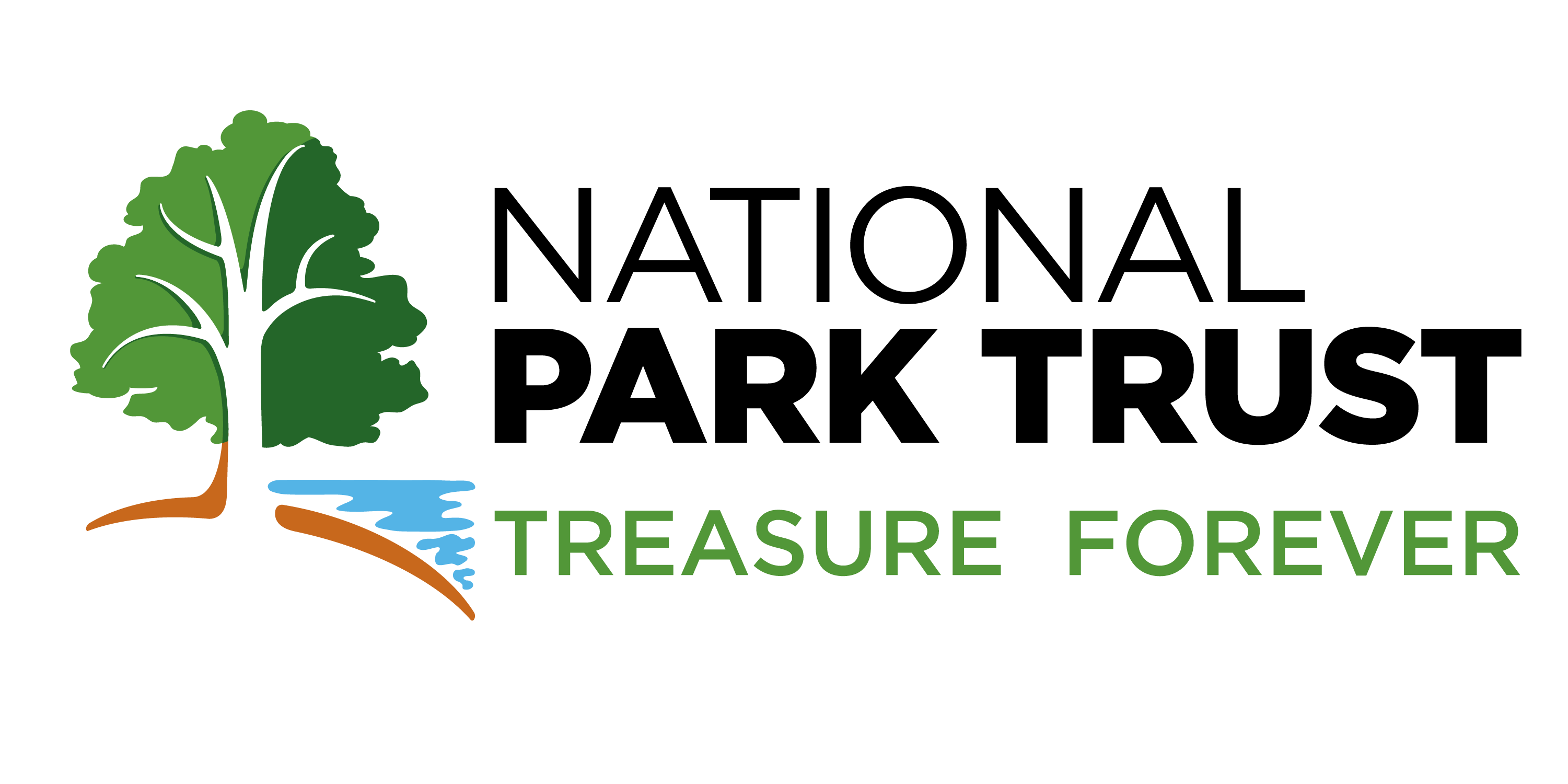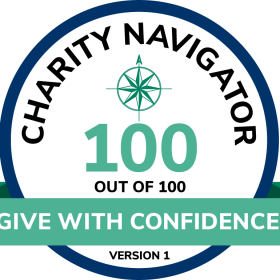Sarah’s Blog
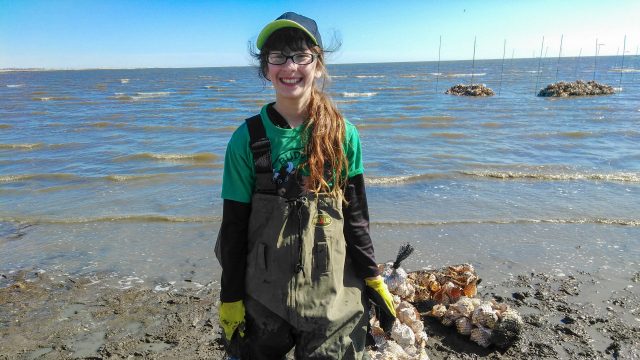

HISTORIC WHITESBOG VILLAGE: EXPLORING NEW JERSEY’S AGRICULTURAL HISTORY

Do you like cranberries and blueberries? Did you ever wonder where they come from? This winter I got to find out how these berries are grown when I visited the Historic Whitesbog Village in Browns Mills, New Jersey. I learned that cranberries are grown here in a special type of land called a bog. The cranberries grow on vines and when they are ripe the bog is flooded with water and the cranberries float to the top of the water. In the beginning of the 1900’s, Whitesbog was the location of the largest cranberry bog in the state of New Jersey, and cranberries are still grown here today.
Whitesbog Village is also famous for being known as the “birthplace of the blueberry.” Elizabeth White, who worked here with her father, grew the first highbush blueberries here in the early 1900s. This is a type of blueberry that farmers still grow in many different states today. She partnered with Dr. Frederick V. Coville to use different types of blueberries that were growing wild in the area and bred them together to make the first cultivated blueberry bushes in New Jersey. Today, the blueberry is the state fruit of New Jersey. In one part of the village you can see the many different types of blueberries that Elizabeth White developed here at Whitesbog.
The Historic Whitesbog Village is part of Brendan T. Byrne State Forest, which is one of the amazing state forests that we have here in New Jersey. It is also part of the New Jersey Pinelands National Reserve. The Pinelands National Reserve is part of the National Park Service covers over one-million acres of farms, forests and wetlands. It is the home for many different types of animals and plants that only live and grow here in the Pinelands. In the pinelands, many of the trees are pine trees and the soil is sandy.
The Historic Whitesbog Village is a great place to visit if you like nature, history, or both! In the Village you can visit the General Store, some of the houses where the workers at the cranberry bog lived, the Barrel Factory, and a Blueberry and Cranberry Museum. You can also visit Suningive, which is the house that Elizabeth White lived in. It is decorated to look like the 1920’s, when Elizabeth lived here.

Near the Village there are also lots of great hiking trails where you can walk around the cranberry bogs and through the forest. The cranberry harvest takes place in the fall, but we were still able to see some cranberries floating around the edges of the cranberry bogs. This is also a great place to see many different types of birds and other wildlife.
The Historic Whitesbog Village has a day each month when volunteers come to help with different projects, so on our visit we helped with organizing and cleaning up in one of the buildings, and then we took a hike to look at the historic buildings and the bogs. I’m really looking forward to coming back soon to volunteer and coming to the Blueberry Festival that they have every year in June!

PRACTICING OUTDOOR SURVIVAL SKILLS WITH BUDDY BISON STUDENT AMBASSADOR SARAH

Have you ever wondered if you would be able to build a fire or a shelter to keep yourself warm in the wilderness? Or if you would be able to find your way without using your phone? This winter I got to visit some parks to learn about different outdoor survival skills, including building a shelter, cooking over a fire, and orienteering.
At Brandywine Creek State Park (Wilmington, DE) I got to learn about shelter building and how to cook over a fire. In the shelter building class, I got to help build two different types of shelters: an A-frame shelter, and a lean-to shelter. The first step to building a shelter is to find all of the materials that you will need, including different sizes of tree branches. The main idea of the shelter is to protect you from rain, snow, wind, or other types of weather.
Once you have all of the branches in place, you can fill in any openings with leaves, pine needles, bark, moss, or any other materials that you can find. The types of materials you can use depends on what types of plants are where you are building the shelter. The most important thing is keeping yourself warm and dry. Luckily, Brandywine Creek State Park had lots of branches and leaves to help us build our shelters. My shelter was just big enough for one person to fit in!
In another class at Brandywine Creek State Park, I learned about building and cooking over fires. The two types of fires I learned about were the teepee-style fire and the log cabin style fire. For both types of fires, you need to collect different materials. The tinder is very important because that is what you will light first. On top of the tinder you would put kindling, which are smaller sticks and branches, and finally you would add the largest pieces of wood. After learning about how to build a fire, I learned about cooking on fires. One important thing that I learned is that if you are cooking meat, like chicken, you need to make sure that the meat is completely cooked, because some parts of the fire may be hotter than other parts.

I also learned that fire safety is very important. When you choose the place that you are going to build your fire, you want to make sure that there are no branches hanging close to the fire, and that the area on the ground where you are building the fire is clear. After you are done cooking and you are ready to put the fire out, you need to use lots and lots of water to make sure that all of the flames are out and that the hot ashes are cool. After learning about building fires, I got to cook pizza pocket pies over the campfire, and they were delicious!
The last outdoor skill that I learned about this winter was orienteering. At Estell Manor County Park (Atlantic County, NJ) I got to take an orienteering class. The class started indoors, where I learned how to use the orienteering compass. Knowing how to use a compass can be very helpful, because if you are in the wilderness your cell phone might not work, and a compass never needs batteries. I learned how to use the orienteering map and the compass to figure out what direction I needed to walk to go in a certain direction. I also learned how to figure out how many steps I would take to travel a certain distance and how to use the map scale.
After learning how to use the compass, I went out into the park to try out the orienteering trail. I used to compass and map to find the different checkpoints on the trail. Each of the checkpoints was marked with a white and red square. As I found each checkpoint, I would use the compass and map to figure out what direction to travel next and how many steps I should be going.
Learning about shelter and fire building, cooking over a fire, and orienteering was so much fun, and I feel like I will be more prepared the next time I will be taking a trip in the outdoors. There are lots more outdoor skills to learn, and I am looking forward to taking some more classes soon!


ORIENTEERING WITH STUDENT AMBASSADOR SARAH

Every good adventurer knows that you can’t always rely on a GPS unit or your cellphone to help you navigate outdoors. Being able to use a compass and a map are important skills when outdoors, especially in the wilderness.
Buddy Bison Student Ambassador Sarah practiced her orienteering skills at a local New Jersey park last weekend. Orienteering is an outdoor activity where you use a compass and paper map to navigate to checkpoints, or “stops”, hidden in a natural area. Sometimes people compete in orienteering competitions to see who can find all the stops the fastest! Read all about Sarah and Buddy Bison’s adventure below:
“This weekend I got to try orienteering at Estell Manor Park, which is a county park in Atlantic County, New Jersey. I started off by learning about orienteering and how to use a compass. If you are hiking in the wilderness, it is really helpful to know how to use a compass, since you might not be able to use your phone, and a compass never needs batteries.
I learned how to use the map and compass together to tell me which direction to go when I’m hiking. One interesting thing I learned is that there is a difference between the direction of the North Pole (Geographic or True North) and the “magnetic north” of the Earth. [A compass uses the Earth’s magnetic field to align with the point of “magnetic north”, which is in a different location than the geographic location of the North Pole. Learn more here.] I also learned how to use the map scale to figure out how far I should be walking between each of the orienteering stops.
Once we learned how to use the compasses, we headed out on the trails. Estell Manor Park has lots of great trails that go through the woods and some of the trails go by the Great Egg Harbor River. There are a few different orienteering trails to try here. Once we were out on the trail, I used the compass and the map scale to find my way to the different stops on the orienteering map. It was cold out and there was still snow on the ground, but I had a great time orienteering at Estell Manor Park. I’m hoping to come back to this park again a try one of the other orienteering trails.”

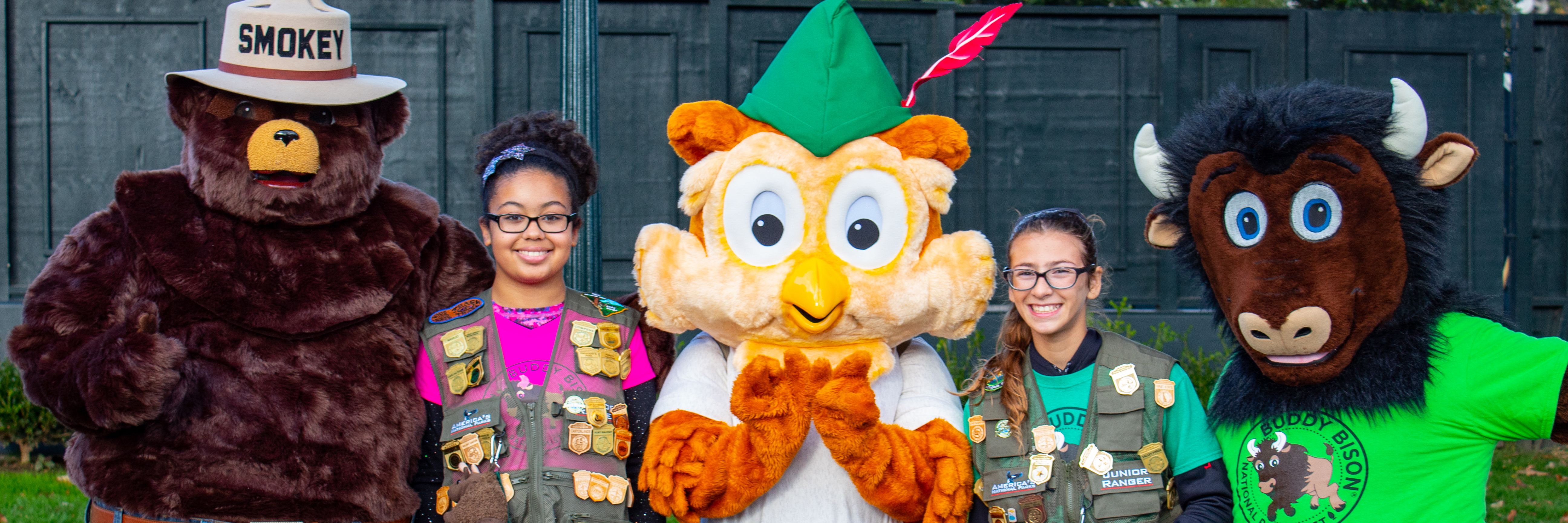
CELEBRATING HALLOWEEN AT THE WHITE HOUSE
Buddy Bison Student Ambassador Sarah had a very special Halloween this year. Sarah traveled to Washington, D.C. to celebrate Halloween at the White House with fellow Student Ambassador Audrey and Buddy Bison! Check out Sarah’s adventure below:
“Did you know that the President of the United States lives in a National Park? The White House is located in President’s Park , which is one of the units of the National Park Service. President’s Park includes the land around the White House, an area called the Ellipse, and Lafayette Park. There are many different statues and memorials in the park areas near the White House.
Student Ambassadors Sarah (right) and Audrey (left) at White House Halloween Event.
Last month, I had an amazing opportunity to visit Washington, D.C., and volunteer on the White House grounds with National Park Trust for a Halloween event. I was able to hand out goodies, such as Buddy Bison stickers and Junior Ranger hats and badges, to lots of children and their families who came to trick-or-treat at the White House. A lot of the families asked questions about my Junior Ranger badges and how they could get their own. It was fun talking with them about some of the parks that I have visited and about parks that they had been to before. I even got to meet Buddy Bison, Smokey Bear, and Woodsy Owl! It was also exciting to get my own President’s Park Junior Ranger badge. There were lots of other government agencies that were handing out treats too, such as the U.S. Park Police, the U.S. Forest Service, and NASA. NASA even brought a moon rock for people to see!
While I was in Washington, D.C. I was able to visit many of the different monuments and memorials that are part of the National Mall and Memorial Parks site.I was able to get my junior ranger badge from there also. My family and I walked around the National Mall and we followed the trail around the Tidal Basin to see some of the memorials. Fall is a great time to visit Washington,D.C., because the leaves on the trees are starting to change color. We saw beautiful leaves as we walked by the Potomac River and around the Tidal Basin and the National Mall.
Some of the monuments that I visited were the Washington Monument, the Lincoln Memorial, the Martin Luther King, Jr. Memorial, and the Franklin Delano Roosevelt Memorial. Each monument and memorial is unique and special, and visiting these places was very inspirational to me. I really enjoyed learning about the history of these places and how they came to be. One of my favorite places was the Lincoln Memorial. Abraham Lincoln has always been one of my favorite presidents, and being able to visit the Lincoln Memorial was a very special moment for me. I can’t wait to visit Washington D.C. again to see more of the parks there!”

“SHELL-A-BRATING” HEALTHY ECOSYSTEMS
This spring, I got to help with a project called the “Shell-A-Bration” in Newport, New Jersey. Newport is a town on the Delaware Bay. The Delaware Bay is a beautiful place with many different types of wildlife. Many people visit the Delaware Bay just to see the amazing birds that stop there during their migrations.
At the Shell-A-Bration I got to help build a reef from bags of whelk shells. The bags are made out of netting so that the water can move through them, but the shells will stay in place. To make the reef, the bags were lined up on the sand so that they will be covered by the water. One of the reasons that the reef was built is to help keep the sand on the beach from washing away. If the beach washes away, the animals that live there will disappear. I had so much fun getting to put on waders and helping to carry the bags of shells down to the water. The bags were pretty heavy, so we made a line where one person would pass the bag of shells to the next person until it got to the water. I definitely got very wet and muddy, but I had a great time.
Sarah standing with whelk shells used to make the reef.
Two animals that really depend on the Delaware Bay are the red knot and the horseshoe crab. The red knot is a bird that migrates every year from South America to the Arctic. In the spring, these birds leave South America and fly up to 9,000 miles to the tundra in the Arctic! They spend the spring and the summer in the Arctic and then fly back to South America for the winter. On the way to the Arctic, the red knots stop at the Delaware Bay to eat lots of food so that they can keep flying. One of their main foods at the Delaware Bay are horseshoe crab eggs.
Horseshoe crabs live in the water in the Delaware Bay. They get their name from their shape. The top part of their body looks like the shape of a horseshoe, and underneath they look like a crab. But they are actually more closely related to spiders than crabs. Once a year, horseshoe crabs come out onto the beaches and lay eggs. It is perfect timing because this happens at the same time when the red knots are stopping at the Delaware Bay on their way to the Arctic. As long as there are enough horseshoe crabs, the red knots will have enough to eat to finish flying to the Arctic. Scientists are worried because there are less red knots than there used to be. One way to help the red knots is to make sure that the horseshoe crabs have a place on the beach to lay their eggs. This is one of the reasons why they are building reefs, like the one that I got to help build at the Shell-A-Bration. Other wildlife, like fish, can also use the reefs as a place to live or to hide from predators.
I really enjoyed volunteering to help build the reef and also learning about animals that live in and around the Delaware Bay. I definitely want to go back next year to help build another reef!

ROLLIN’ ON THE RIVER

Stewardship is an important part of our mission here at National Park Trust, and Buddy Bison Student Ambassador Sarah Hullihen is a great example of what a park steward should be! She recently returned to the Maurice River, a National Scenic and Recreational River, where she participated in the South Jersey Waterways Cleanup to collect trash and beautify the area. Sarah is even organizing a litter pick-up challenge for Kids to Parks Day! Read more about her project below:
“As a Buddy Bison Student Ambassador, I love volunteering at parks. One of my favorite projects to help with at parks are park cleanups. It’s so important to keep litter out of parks because litter is harmful to plants and animals, and you don’t want to see trash around when you are visiting a park. Recently, I got to volunteer to help clean up different places near the Maurice River in New Jersey for the South Jersey Waterways Cleanup.
The Maurice River is a very special place, and I am lucky to live close by. It is a National Scenic and Recreational River, and it is protected by the Wild and Scenic Rivers Act. This year, 2018, happens to be the 50th anniversary of the Wild and Scenic Rivers Act. The river is a great place to see all kinds of wildlife, especially birds like osprey, and one of my favorite animals, the bald eagle. Last year I got to see a whole family of bald eagles in their nest! There are also many endangered plants and animals that depend on the Maurice River, so it is definitely an important and special place. I have been able to go kayaking and also boating on the river, and it is amazing! There are also lots of great places to hike near different parts of the Maurice River.
There are many homes and businesses near different parts of the Maurice River, and unfortunately a lot of litter too. Litter that gets into the river can eventually go all the way to the Delaware Bay and then into the ocean. At the South Jersey Waterways Cleanup we spent time cleaning trash from a few different areas around the river, and we even found litter in the river too. Many of the things that we collected could be recycled, so we had different bags for those things and other bags for things that had to go in the trash. Even though the parks near the river all have trash and recycling containers, many people don’t use them.
When my family and I visit parks and other outdoor places, we bring along bags and gloves so that we can pick up any litter if we see it. One of the activities that I am planning for Kids to Parks Day this year is a litter pick-up challenge. The challenge will be to see who can pick up the most litter and things that can be recycled. I hope that everyone will realize how important it is to keep our parks and outdoor places clean, and they will want to help with a park cleanup too.”

CITIZEN SCIENTIST SARAH

Citizen science projects let anyone become a scientist for a day! In 2017, Buddy Bison Student Ambassador Sarah Hullihen volunteered at the Maurice River (NJ), which is a part of the National Wild and Scenic River System. Sarah helped National Park Service staff and local scientists collected dragonfly larvae for an ongoing national project that investigates mercury levels in dragonflies. Read more about Sarah’s contributions below:
One of my favorite things about being a Buddy Bison Student Ambassador is volunteering to help in different parks. One of the great places that I have gotten to volunteer at is the Maurice Wild and Scenic River here in New Jersey. A project that I got to help with was a citizen science project collecting dragonfly larvae for a National Park Service nationwide study. The group that I volunteered with is called the Citizens United to Protect the Maurice River and its Tributaries. They work with the National Park Service to help protect the Maurice River and the places around it.
My favorite part of volunteering with the dragonfly sampling project was getting to paddle a canoe out on the river and using nets to collect dragonfly larvae. Sometimes the larvae were hard to find since they are really well camouflaged! I also helped collect dragonfly larvae from around the water plants near the edge of the water. After we collected the larvae, we brought them back to the shore and put them into tubs of water. While the larvae were in the tubs, we had to identify what type of dragonfly larvae they were. This was a little difficult, but we had pictures to help out. The larvae also need to be a certain size to be sent for mercury testing, so we had to use rulers to measure them. We then had to label a bag for each dragonfly larvae so that it could be sent to a lab. The dragonfly that I helped collect were sent to a lab to be tested for mercury. The mercury builds up in different animals and is then passed along the food chain. I learned that mercury can be harmful to all different types of wildlife, which is why the National Park Service is doing this research project. There are different parks all across the United States that collect dragonfly larvae for this project.
The Maurice River is a beautiful place to visit, and It was really interesting learning about different types of dragonflies. I also saw lots of other wildlife, like turtles, monarch butterflies, fish, and birds. I had a great time, and I’m really looking forward to volunteering again next year!
Follow Sarah’s adventures on social media @jrrangersarah.

ON PATROL WITH THE CRAYFISH CORPS

Earlier this summer, Buddy Bison Student Ambassador Sarah Hullihen who lives in southern New Jersey, volunteered with the Crayfish Corps to help remove invasive rusty crayfish from a stream in Valley Forge National Historical Park (PA). An invasive species is a plant or animal that gets introduced into an area but is not native to it. Over time, the invasive species begin to out-compete native plants or animals for resources. Read about Sarah’s experience below.
“In August, I went to Valley Forge National Historical Park to volunteer for the Crayfish Corps. Back in 2008, the rusty crayfish became an invasive species in Valley Creek, and soon started to dominate over the native crayfish. Rusty crayfish are originally from the Ohio River Basin. The rusty crayfish were harming the native crayfish population very badly. They ate too much of the food that the natives ate, and were also overpopulating the creek. So, to try and solve that problem, the Crayfish Corps has to try and take out rusty crayfish from the creek . The park tries to have one or less rusty crayfish for every four native crayfish in the creek.
The crayfish live under rocks in the creek, so I would lift up a rock and put the net downstream so that the crayfish would move into the net. I then had to identify the crayfish. I learned that the rusty crayfish has rusty-colored spots on its sides and black bands on the claws. After I identified the crayfish, if it was a native, I would count it and put it back in the creek. If it was rusty, it would be put in a bucket. The rusty crayfish would then be frozen and put in the forest to dispose of. In about two hours, our group found about 44 native crayfish and about 10 rusty crayfish. We did find many more native crayfish than rusty crayfish, so that is a really good sign. I had a lot of fun volunteering, so if are ever in Valley Forge National Historical Park, make sure to find out about the Crayfish Corps!
Thanks Sarah for giving back to YOUR local park!

ADVENTURES IN ARCHAEOLOGY

Our Buddy Bison Student Ambassador, Sarah Hullihen, visited Brandywine Springs Park in Delaware this month to take part in an archeological dig with The Friends of Brandywine Springs. Not only are parks a great place to explore outdoors, but they also help protect and preserve our shared history and culture. Read Sarah’s story below to find out what “dazzling” history Sarah helped unearth:
“When you visit Brandywine Springs Park in New Castle County, Delaware, you will see tall trees, a beautiful creek, and many different types of wildlife. But what you might not know is that there once an amusement park here, with a boardwalk, roller coaster, carousel, and much more.
This park and historical site is one of my favorites so far. In the early 1800’s, there was a hotel where the parking lot of the park is today. People came to drink water from the Chalybeate Spring, and the water there was supposed to help keep you healthy. Later in the 1800’s, the amusement park opened and stayed open until 1924.
The Friends of Brandywine Springs is a volunteer group that does archaeological digs in the park. They have put up signs with pictures around the park to show the locations of different rides and buildings from the amusement park. When I was there, I helped with an archaeological dig to find the location of a ride called the Razzle Dazzle. The ride would be pulled manually with ropes for the ride to go up, down, and around.
During the dig, we were looking for a curb to show where the Razzle Dazzle ride would have been. We used tools, such as shovels, trowels, and brushes to dig around the area. We eventually did find it, and some other cool things too, like the end of a lightbulb, some electrical wire, and pieces of roofing. I also found out that archaeology can be very challenging, and many times when I thought that I had found something it turned out to just be a rock. The Friends of Brandywine Springs will be back to continue the dig here. The entire dig was a lot of fun and a great experience for me, so if you have a chance to do an archaeological dig like I did, I hope you give it a try!”

AMBASSADOR SARAH: PROMOTING KIDS TO PARKS DAY IN VINELAND, NJ
For Buddy Bison Student Ambassador Sarah Hullihen, May 20th was a particularly meaningful day. Sarah hosted a Kids to Parks Day event in her hometown of Vineland, NJ, and even engaged the city to help!
“To make this event possible, I met with the Vineland Environmental Commission to help get everything ready and set up to plan different activities. National Park Trust also suggested that we get a proclamation from our mayor for this special event. A few weeks before the event, I met with Mayor Fanucci to receive Vineland’s Kids to Parks Day 2017 Proclamation.
[At our event] we had a great activity sheet with 7 fun outdoor activities on it and a station for each activity. Some of the activities were “Art In The Park,” which featured art supplies where you could color, draw, paint, and do leaf rubbings; “Color Hike” where you had to find something on your hike that matched with different colors; “100 Things to do at Parks” poster where people wrote ideas of activities to do at parks; and my favorite, the “Read It Forward” station, where you took a book and when you are finished reading it, you “Read It Forward” by giving someone else the book. The Vineland Environmental Commission also had information about all of the great parks and natural areas that we have here in Vineland.
I also led hikes during our Vineland Kids to Parks Day event. On the hikes, we took along supplies to pick up litter and help keep the park clean. Another hike that I led was an “A to Z Hike” where we had to find something that started with each letter of the alphabet. We had to be very creative to find some of the letters.”
Wow, Sarah! Your leadership made this day memorable for your local kids – thank you!

AMBASSADOR SARAH: EXPLORING OUR PUBLIC LANDS
As a Buddy Bison Student Ambassador, Sarah Hullihen, a middle schooler from New Jersey, loves to explore local, state and national parks. Over the past year, Sarah has brought me on adventures to a number of public lands, including forests, monuments, and wildlife refuges. Check out her recent trip to the Edwin B. Forsythe National Wildlife Refuge in southern New Jersey and see why it’s such an amazing place:
As a Buddy Bison Student Ambassador, I get to explore our amazing local, state, and national parks. There are many other public lands that you can visit and explore, such as forests, monuments, and wildlife refuges. Buddy Bison and I recently got to visit Edwin B. Forsythe National Wildlife Refuge in southern New Jersey. This wildlife refuge manages and creates habitats for wildlife in this area. In the fall and spring, many migrating birds stop in the salt marshes and tall grasses here to find food and shelter. It is part of what is called the “Atlantic Flyway” because so many birds travel through here during migrations. You can visit here during different seasons and see different wildlife each time.
If you visit the Edwin B. Forsythe refuge, one of the cool things that you can do is go on the Wildlife Drive. This is an 8-mile long road that you can drive on around part of the refuge to see lots of birds and other wildlife. Along the way you will see signs telling you about the wildlife, the history of the refuge, and how the refuge makes habitats for different types of birds. Some of the things that you might see on the drive are a nesting platform for peregrine falcons, hawks, a turtle crossing, and maybe even a bald eagle!
There are also hiking trails around the marshes and some of the forest areas, and a visitor’s center. At the visitor’s center there are some really awesome exhibits about the habitats and animals in the refuge. One of the exhibits plays samples of bird songs, so that you can try and identify those birds as you are exploring outside. They even have an “Osprey Cam” where you can watch what is happening in one of the osprey nests. At the visitor’s center, you can also borrow bird identification books and binoculars to use when you are exploring. One thing that I really enjoyed at the refuge was the Junior Refuge Manager book and badge. When you visit the different parts of the refuge, you fill out the pages in the book, and then you can get a Junior Refuge Manager badge! So the next time you are ready to get out and explore, think about one of our great public lands, like your nearest wildlife refuge.
Thanks Sarah for this wonderful story and sharing some neat things about the refuge. You can follow Sarah’s adventures on social media (@jrrangersarah) and on her blog.

BRINGING HISTORY TO LIFE
In addition to preserving treasured natural areas, national parks celebrate the rich history and influential historical figures that have helped shape our country. Our Buddy Bison Student Ambassador, Sarah Hullihen, knows a thing or two about historical parks and recently explored some new locations with me:
Have you ever wondered what it would be like to walk in the footsteps of Alexander Hamilton, Marquis de Lafayette, or even George Washington? One of the reasons I really enjoy visiting historical parks is that they can help bring history to life. Three historical parks that I have recently visited are Washington’s Crossing Historic Park, Valley Forge National Historical Park, and Brandywine Battlefield Park. These parks are all places that help tell the story of the Revolutionary War.
Washington’s Crossing Historic Park is the place where George Washington and his troops crossed the Delaware River on the night of December 25, 1776. I got to see a reenactment of Washington and his troops crossing the river, and it was very exciting, and also very educational.Brandywine Battlefield Park is located where a battle of the Revolutionary War was fought on September 11, 1777. When you visit here, you can see a house used for General Washington’s headquarters and the fields where the soldiers fought.
General Washington and the Continental Army stayed at Valley Forge during the winter of 1777. Today you can visit Valley Forge National Historic Park and see huts built to look like the ones soldiers would have stayed in during the Revolutionary War. If you complete the Junior Ranger badge program, you will learn all about the history of this park. Visiting historical parks is awesome because you can learn a lot and have fun too!
Follow Sarah’s adventures on social media (@jrrangersarah) and make sure to check out her blog.

THAT’S A FIRST: AMBASSADOR SARAH’S ADVENTURES
What an exciting fall for our newest Buddy Bison Student Ambassador, Sarah Hullihen! Remember when Sarah participated in the National Park Service Centennial celebration at Independence National Historical Park? Well, Sarah has kept the adventures going and recently stopped by the First State National Historical Park in New Castle, DE. She shared about her experience in her letter:
“Did you know that the “First State” was actually the last state to get a National Park Service unit? First State National Historical Park is made up of sites all the way from the northern to the southern parts of the state of Delaware. This park was created in 2013 as the First State National Monument. Since I love visiting historical sites, this was the perfect park for me to visit. And, this year happens to be the 50th anniversary of the National Historic Preservation Act. I was even able to get a special wooden Junior Ranger badge during my visit!
I learned that the sites that make up First State National Historical Park tell the story of the many different groups of people who have settled and lived in Delaware. At Fort Christina in Wilmington, a monument marks where Swedish settlers landed in 1638. Holy Trinity Church, also called Old Swedes Church, is also in Wilmington, and both of these places are National Historic Landmarks. Some of these buildings are as old as the seventeenth century. So, next time you are passing by Delaware, make sure to check out the National Park unit sites there.”
Follow Sarah’s adventures on social media (@jrrangersarah) and make sure to check out her blog. You can read her full letter here.

INDEPENDENCE NATIONAL PARK WITH AMBASSADOR SARAH
Sarah Hullihen, our newest Buddy Bison Student Ambassador, wants all of us to know the importance and significance of the NPS Centennial. Naturally, with service as our theme, Sarah celebrated the day by volunteering at one of her favorite parks, Independence National Historical Park in Philadelphia, PA and sharing this blog:
“Do YOU know where Buddy Bison’s been? Well, during the National Park Service Centennial celebration, I was at Independence National Historical Park.
First of all, let’s talk about the plaque I saw being unveiled in honor of Stephen Mather. He was the first director of the National Park Service. In honor of the one hundred years, at 1:00 they gave out cupcakes. In the rest of my explorations of the park, I got to see the Liberty Bell Center, the Bishop White House, the Second Bank of the U.S., and Independence Hall, where I put my hand on the same railing on the stairs that Ben Franklin walked up.
To me, the Centennial celebration represents everyone’s hard work paying off for the first 100 years of the National Park Service. One of the most amazing things about our national parks is how much you can learn and experience, and I hope everyone can find something special that they like in each of the parks they visit. The next time you’re at a national park, make sure you share where you have been with Buddy Bison!”
Read more about Sarah’s adventures on her blog and follow her on social media @jrrangersarah.

MEET SARAH: BUDDY BISON STUDENT AMBASSADOR
Sarah Hullihen, age 11, and her younger sister Lauren, age 6, won first prize at the National Constitution Center for their Abraham Lincoln and George Washington costumes. Photo courtesy of Cheryl Hullihen.
Meet Sarah: Buddy Bison Student Ambassador
I am excited to announce Sarah Hullihen as our second Buddy Bison Student Ambassador. Sarah is a rising sixth grader at the Applied Math and Science Academy at Veteran’s Memorial Middle School (Vineland, NJ). She was welcomed to our ambassador program by our first ambassador, Tigran Nahabedian, who attendsOjai Valley School (Ojai, CA). Sarah stated:
“I am super excited for this opportunity to be a Buddy Bison Student Ambassador, because I already love spending time in parks, and as a student ambassador, I will get to visit even more parks and try lots of new activities. I am also looking forward to sharing my ideas of fun activities to try in parks with other students around the United States. Parks and historical sites are so important to me because I love to see and learn about nature and history, and I want other people to know that they are oh so very important too.”
Fun fact about Sarah – prior to becoming a Buddy Bison Student Ambassador, she already loved cultural and historical parks. For President’s Day, she dressed up as Abraham Lincoln for a costume contest at the National Constitution Center (picture above) and won! Read more about Sarah’s adventures on her blog and follow her @jrrangersarah.
A big Buddy Bison welcome to Sarah! We look forward to featuring her blogs and park stories in future issues of Buzz.
